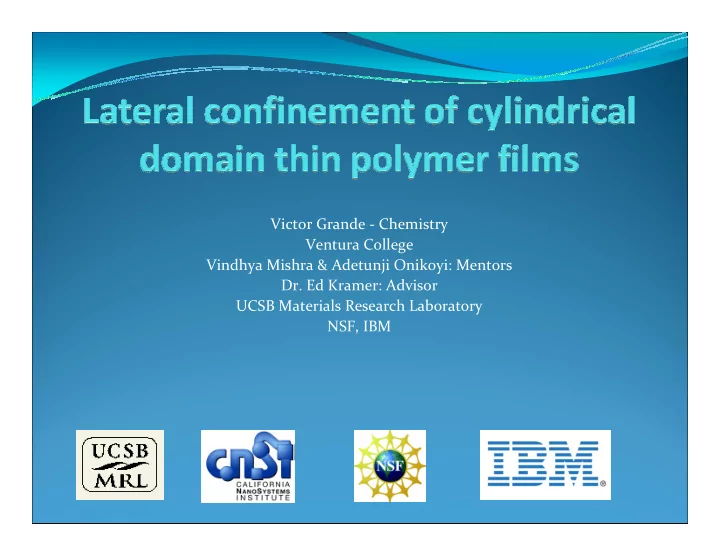

Victor Grande ‐ Chemistry Ventura College Vindhya Mishra & Adetunji Onikoyi: Mentors Dr. Ed Kramer: Advisor UCSB Materials Research Laboratory NSF, IBM
What is a polymer? � Repeated structural units linked by covalent bonds � Block copolymers � Two polymer chains linked by a covalent bond Poly (styrene-b-vinyl pyridine)
Block copolymer phase behavior Cross-sectional view
Why study this system? � Nanolithography: alternate method for creating masks with nanofeatures � Current methods: photolithography, e ‐ beam lithography � Can’t create structures smaller than wavelength ( λ) of light � Ultraviolet and X ‐ rays possible, but still expensive � Obtain even smaller features � Nanowires � Etch away the PVP to leave nanocylindrical holes behind � Fill with metallic salt to make nanowires
What do we hope to accomplish? � The block copolymer Poly (styrene ‐ b ‐ 2 ‐ vinyl pyridine), or PS ‐ PVP, self ‐ assembles into a cylindrical array � 25% PVP : volume ratio � Pattern is disordered � We aim to improve translational and orientational order by graphoepitaxy � Using substrate to direct growth of overlying material Disordered system Ordered system
Experimental Method � Film casting � Annealing � Imaging � Secondary Ion Mass Spectrometry (SIMS) � Atomic Force Microscopy (AFM)
Preparation of ordered films � Dissolve polymer in toluene � 2% mass solution � Spin coat on a silicon (Si) wafer at a specific rpm for 45 seconds � Thickness is inversely proportional to spin speed � We are targeting films of a specific thickness
Annealing � Heat beyond the Order ‐ Disorder Temperature (ODT) � ODT for PS ‐ PVP is ~ 220°C � Cool down to the annealing temperature � Range of annealing temp. (AT) is ~150 ‐ 200° C � We hold it at the AT for 2 days
Accessing the ‘buried structure’ � Secondary Ion Mass Spectrometry (SIMS) to etch through PS film � Process exposes cylinders � Analyze cylinder patterns using Atomic Force Microscopy (AFM)
Data collection � We looked at two different kinds of films � Unconfined films � Polymer spun coat on a plain Si wafer � Confined films � Polymer spun coat on a patterned wafer Mesas Wells SiO 2 Si Top view Cross-sectional view
Disordered System (Plain Si wafer) AFM Height Scan AFM Phase Scan
Confined system (patterned wafer) Mesa Cylinders AFM Phase Scan AFM Height Scan
Comparison of width Width of channel ~ 1.36 µ m Width of channel ~ 0.23 µ m
Monolayer Defect Densities Defects 100 n dislocation (# / µ m 2 ) 80 � For monolayer, dislocation 60 density is low but nonzero 40 � Disclination density is zero 20 0 100 120 140 160 180 200 80 n disclination (# / µ m 2 ) 70 60 50 40 30 20 10 0 100 120 140 160 180 200 Graphs courtesy of M. R. Hammond: In-Plane Temperature (°C) Microdomain Order in Cylindrical Block Copolymer Thin Films, 2005 , Macromolecules
Summary � Accomplishments � Learned about block copolymers � Improved translational and orientational order of cylinders � Learned how to operate AFM � Use existing methods to create smaller structures � Save $$$$$$
Future plans � Quantification of defect density � Compare the effects of channel walls to an unconstrained system � Determine the effects of channel width and temperature � Find the cause of defects
Acknowledgements Vindhya Mishra Tunji Onikoyi The Kramer Group Mike Dimitriou Jens Kuhn Dr. Nick Arnold Special thanks to Dr. Evelyn Hu and Liu ‐ Yen Kramer CNSI, NSF, IBM
B B B B B B B Block Copolymers A A A A A A
AFM Phase Image Approx. width of cylinder = 9.08 nm Approx. spacing = 11.3 nm . 458nm . 336 nm Patterned Si wafer
Bilayers Monolayer
� Top ‐ down � Start w/bulk and remove unwanted material � Destructive procedure � Bottom ‐ up � Start from a scale smaller than desired feature size (e.g. molecular level to create nanofeatures) � Build up from that � Spontaneous building up = self ‐ assembly � Thermodynamically favored
Recommend
More recommend